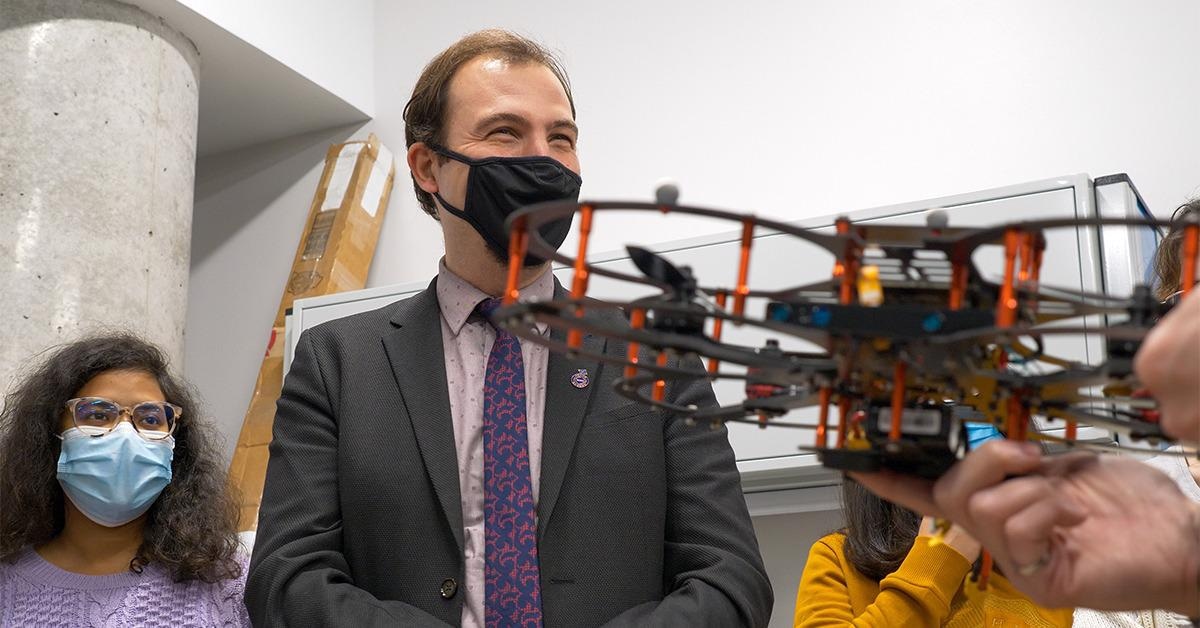
Image Credit: University of Ottawa
Situated in Ottawa’s Kanata North campus, in the center of Canada’s largest technology park, the Smart Connected Vehicles Innovation Center will help the tech sector speed up autonomous vehicle modernization.
The term “smart vehicle” or “autonomous vehicle,” refers to any vehicle fitted with decision-making systems and sensors that enable it to identify its surroundings. Self-driving cars naturally come to mind, but bots and drones also fall under this ecosystem.
What excites me most is that we’re essentially envisioning the future of this technology, which will soon be ubiquitous and indispensable to society. We’re working with industry on different topics simultaneously and finding solutions to problems that the tech world is facing. It’s never just a single problem or a single solution, so it requires a lot of imagination.
Burak Kantarci, Professor, University of Ottawa
The center provides fast, economical experimentation for connected and autonomous vehicles, including drones, self-driving car prototypes and specific types of ground bots. Its research will concentrate mainly on problem-solving issues linked to the physical and cyber security, connectivity, decision making and sustainability of networks and vehicles.
In other words, we design experiments to assess how these vehicles talk to each other and their connected units, making sure they maintain healthy communication, making sure sensors aren’t compromised, so they don’t break down.
Burak Kantarci, Professor, University of Ottawa
“We try to anticipate where anomalies can occur in the platforms and find ways to reconfigure networks to avoid these anomalies happening in the first place, so there is no service disruption for the end user,” Kantarci added.
The uniqueness of the center is that it is an open-access research unit. Not only is it located in one of Canada’s largest technology development hubs, but it is also designed to bring together professionals from different fields — economists, social scientists, ethics and compliance experts and decision-makers, together with computer scientists and engineers — to take full advantage of innovation.
“The Smart Connected Vehicles Innovation Centre is vital to realizing our vision of building a successful technology ecosystem in Kanata North,” says Sylvain Charbonneau, vice-president, research at the University of Ottawa. “It’s forward-looking research will be a valuable asset to the development of real-life applications in this rapidly growing industry.”
“This new, highly relevant research infrastructure, complemented with some of our brightest talent, offers a compelling advantage to our industry partners looking to de-risk and accelerate prototyping of their solutions for faster time to market,” says Veronica Farmer, director, partnerships and commercialization, at uOttawa Kanata North.
The indoor experimental test of the center bed has been combined with advanced computing infrastructure for gathering huge amounts of data, together with robust workstations for working innovative machine-learning models.
One of the biggest challenges starting out in this field was finding data. “Through our experiments, we will be able to generate this data in real-time and for any scenario. And that’s what’s most valuable. It’s going to be our fuel of the next decade.
Burak Kantarci, Professor, University of Ottawa
Kantarci’s research team and its collaborators are supported by the Natural Sciences and Engineering Research Council of Canada (NSERC) through its Alliance grants program. The team recently formulated a strategy to launch AI-driven autonomous vehicles serving as COVID-19 rapid testing units into exposed, at-risk groups to help them decrease the spread of the virus.
First, they used mobility data to detect where diseased populations might be situated. Then, they evaluated the risk levels for various communities or regions, to map out ideal trajectories and use their mobile testing units to detect individuals who had contracted the virus as soon as possible.
The AI-driven decision models could also assist health officials and supply chain solution providers in making more effective decisions during the current pandemic or future health disasters.
“For a long time, vehicles were not much more than a means of transportation,” says Kantarci. “But from now on, and in the future, connected autonomous vehicles are going to be used for everything, everywhere.”